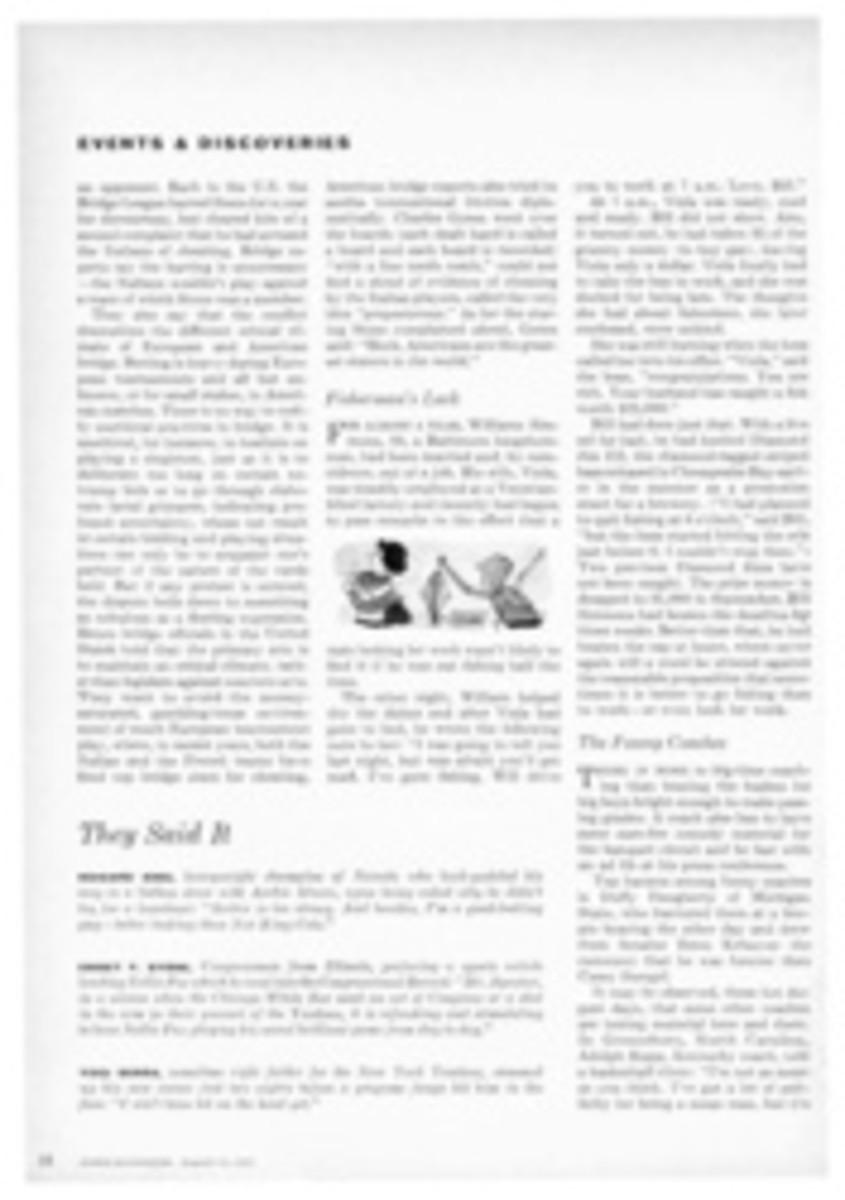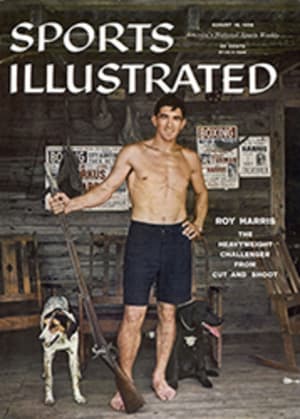
TOWARD A PHYSIOLOGICAL ABSOLUTE
With the upsurge of big athletic meetings after the war arid all the talk of tracks, the men who ran Dublin's Clonliffe Harriers thought Ireland should have a sports stadium with a track as good as any other country's. Now it looks as if Ireland has not just got a track that is as good as anyone else's: it has 440 yards which are the best and fastest in the world.
In a small, tree-surrounded park just off the main road to Dublin airport, one man last week led four others through the four-minute barrier to lop 3½ seconds off the listed world record for the mile, and a stubby Australian who four weeks earlier had shortened the three-mile record to 13:10.8 cut 1.4 seconds off the two-mile time.
"It's the Irish atmosphere," explained the 48-year-old optician Billy Morton, Clonliffe's secretary since 1943. The athletes agreed that he had something. "Usually," said Australia's Herb Elliott, holder of the new-mile record of 3:54.5, "I'm all tensed up before a race, but here I did not care. I never felt better."
When Ron Delany brought home his gold medal from Melbourne, Morton, the man who had first persuaded him to be a miler, announced that at long last there was a definite plan for a sports stadium. He had a site. All that was needed was the money. This did not deter the little Irish club or its chunky secretary. "Billy Morton," said a clubman with unconcealed admiration, "should have been a parish priest. He'd build a marvelous new church and then he'd put a big notice in the front garden saying how much he owed."
At a fund-raising party Dublin's first-ever Jewish Lord Mayor Bob Briscoe kicked off with a £25 gift. From the U.S. came assistance from Shovel Manufacturer Bernard McDonough, and in due course a grinning Delany was able to predict: "I expect loads of world records to be broken here, Billy."
The first came in July, before the paint was dry on the railings, when Albert Thomas, a 23-year-old transport clerk from Sydney, pounded round in a new three-mile record clip of 13:10.8. Impresario Morton followed up this with a two-day meeting to coincide with the Dublin horse show. So many people wanted to get in to see if local lad Delany would beat Herb Elliott that drivers had to abandon their cars in the traffic jam two miles from the track. "We planned for a maximum of 17,500," said Morton, "but the civic guards advised us to let in the crowd outside and take their money to prevent the gates from being pushed in. So we had 22,000 in the end. It suited us grand," chuckled Morton, "as it brought in the best part of another 1,000 sorely needed pounds."
Thomas—at 5 feet 5 and scaling 130 pounds, probably the smallest world record runner ever—set the pace for the mile invitation race, highlight of the night. Herb Elliott lay fourth behind fellow Aussie Merv Lincoln and Murray Halberg, the 25-year-old schoolteacher ("and I do odd jobs around the place") from Auckland. Delany highstepped along sixth in a field of 11, thinking the pace was too hot to last. Time for the first quarter: 56 seconds.
A brown-white mongrel darted out of the crowd at the start of the second lap and yelped after the leaders, with officials leaping about to get him off. They caught him between the last four runners.
The little clerk from Sydney kept up the pace in the second quarter, leading the string around in much the same order to give a time of 1:58 for the first half. Elliott then really let himself go.
Delany knew he could not catch him—"short of tying his legs, there is no way of stopping the guy"—but he tried to overhaul the leaders. So did Murray Halberg, and the furious tussle between the New Zealander and Delany almost gave the Dublin fans heart failure. Elliott, now ahead of Lincoln, streaked ahead at the sound of the ship's bell bought by Morton at a Dublin auction. The three-quarters time was 2:59. Then 20-year-old Elliott—"I still wasn't sure this was record time"—amazingly increased the tempo of his lanky legs and, with the wild roaring of 22,000 pairs of lusty Dublin lungs throbbing through every fiber, he burst the tapes VA seconds inside John Landy's world record of 3:58. His unofficial time for the 1,500 meters—3:39.6—was also under the listed mark. But it was not because of Elliott's fantastic sprint that sports-writers dubbed it the miracle mile. Incredulity was fostered by the times of the four runners-up—Lincoln, 3:55.9, Delany, 3:57.5, and Murray Halberg, although placed fourth, with the same time as Delany. Fifth man, stocky "pacemaker" Bert Thomas, to his own amazement, joined the sub-four-minute club with a time of 3:58.6.
Elliott, fresh enough to do it again, praised the track, the audience, the atmosphere and the help from "Merv and Ron." Looking at Elliott with mock despair, Delany cracked: "I think I'll take Merv up on his offer to play him at tennis."
Half an hour later, back in the dressing rooms, Thomas was still jumping up and down whooping for joy, chanting "three fifty-eight six"—his time. "Oh, I've fallen in love with this track. First a three-mile record and now the four-minute barrier. Whee. Wonderful."
Next night Thomas wanted to take the track home with him to Australia. That was the night he broke the world two-mile record of 8:33.4 belonging to Hungarian Sandor Iharos by 1.4 seconds, and in the four-mile race Murray Halberg clipped over 12 seconds off the best-ever 18:35.3 returned by Gordon Pirie at Perry Barr. The same night, the competitors in the other events smashed just about all the Irish allcomers' records which had not already been toppled on the new Santry track.
RECORDS IN ANY CASE
The job of building the record-breaking track was given to En-Tout-Cas Company, Ltd., of Leicester, England which built the Melbourne, Cardiff, London's White City and Wembley tracks. Its orders were to build a replica of the Melbourne track on which Ronnie Delany brought fame to Irish athletics, but it produced a foot-deep track which is probably better than a replica. When the site had been excavated, nine inches of cinders, obtained from Dublin's famous Guinness Breweries, were laid down, and on top of that 300 tons of a special combination ("three inches of top secret," mysteriously claims the English company) of clays, some burned, and small quantities of shale and sand. The clay gives the track its reddish hue.
"But the Irish weather," Morton added, "gives the track an extra something. Other countries have to water their tracks. We don't." Dublin's May, June and July were the wettest ever recorded (17½ inches). "The subsoil is very hard. The foreman on the building of the terracing said to me, 'Billy, you could put a 60-story building up here without a foundation.' The water doesn't get away quickly. The drainage is bad and we're beginning to realize that's a good thing for the track.
"The beauty of the track," went on Morton, who can talk for hours about it, "is that your spikes go down and come out clean. You could run on it for a month and it would need no attention at all. When we held the military tattoo [a money-raising idea of Billy's which was sunk by the weather] we were flooded out of the place with rain. We seemed to have fifty thousand army men on motor bicycles charging up and down the track. The officer in charge said to me the other night, 'We did a great job in consolidating the track for you.' Perhaps it was a blessing in disguise, although we did not think so at the time. Now the track is well settled anyway."
Leveling the arena and laying the track cost ¬£8,500. "And we still owe ¬£2,500 of that," rapped the optician. "And we owe the company which put up our concrete terracing ¬£8,500. If we had had a normally fair summer I think we would have been able to pay it all off, but now we'll need an American millionaire to rescue us...I'm serious about needing an American millionaire, since we've got no rich Irishmen interested in us. Tell you what I'll do, and I'm serious. For $60,000—it will have to be 60,000—I will name the stadium after him." The way Billy said that, it sounded the most fabulous bargain ever.
PHOTO
ELLIOTT TAKES THE LEAD FROM LINCOLN, THOMAS, HALBERG AND DELANY; ALL FIVE MEN CRACKED THE FOUR MINUTES
Elliott's undoubted ability (he is the world's greatest middle-distance runner) effectively banishes one's first thoughts that there might have been sand in the Irish stopwatches or that the new Santry track, two inches over the quarter mile when Thomas broke the three-mile world record over a month ago, has shrunk in the July rain or had too many shamrocks shaved away from its corners. The approved caliber of Elliott's companions removes any remaining doubt. For all these runners the burden of a representative meeting, like the Empire Games, in which victory was more important than record breaking, had vanished. Ireland has a strangely liberating influence on foreigners, and the Australians seized their chance.
What is the ultimate in miling? Four minutes was only a milestone with the magical ring of round numbers on the path to a physiological absolute which axiomatically runners will never reach, though they will approach it more closely. Unless there is a process of eugenic selection of athletes—horrible thought—the limit depends on the athlete's ability to transport oxygen to his muscles. Over this distance without oxygen the muscles can no longer be driven by the mind. Runners depend on two methods of obtaining energy. The first, used in sprinting, avoids the need for oxygen until the race is over. This overdraft or "oxygen debt" cannot be greatly increased by training. Hence sprint records are equaled rather than broken. In the mile, half the energy comes from this source, while the remainder is supplied by a second route of oxygen transport to the muscles by the lungs and the heart during the race. The improvement in middle and distance records has resulted from the improvement of current oxygen uptake during running, and more efficient use of the oxygen available. A mile in 3 minutes 30 seconds is impossible with the present human physique, but there remains a no man's land of 24.5 seconds. Gradual improvement is inexorable.

